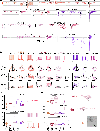Morphoelectric and transcriptomic divergence of the layer 1 interneuron repertoire in human versus mouse neocortex
- PMID: 37824667
- PMCID: PMC11864503
- DOI: 10.1126/science.adf0805
Morphoelectric and transcriptomic divergence of the layer 1 interneuron repertoire in human versus mouse neocortex
Abstract
Neocortical layer 1 (L1) is a site of convergence between pyramidal-neuron dendrites and feedback axons where local inhibitory signaling can profoundly shape cortical processing. Evolutionary expansion of human neocortex is marked by distinctive pyramidal neurons with extensive L1 branching, but whether L1 interneurons are similarly diverse is underexplored. Using Patch-seq recordings from human neurosurgical tissue, we identified four transcriptomic subclasses with mouse L1 homologs, along with distinct subtypes and types unmatched in mouse L1. Subclass and subtype comparisons showed stronger transcriptomic differences in human L1 and were correlated with strong morphoelectric variability along dimensions distinct from mouse L1 variability. Accompanied by greater layer thickness and other cytoarchitecture changes, these findings suggest that L1 has diverged in evolution, reflecting the demands of regulating the expanded human neocortical circuit.
Conflict of interest statement
Figures






References
-
- Cohen-Kashi Malina K, Tsivourakis E, Kushinsky D, Apelblat D, Shtiglitz S, Zohar E, Sokoletsky M, Tasaka G, Mizrahi A, Lampl I, Spiegel I, NDNF interneurons in layer 1 gain-modulate whole cortical columns according to an animal’s behavioral state. Neuron. 109, 2150–2164.e5 (2021). - PubMed
-
- Letzkus JJ, Wolff SBE, Meyer EMM, Tovote P, Courtin J, Herry C, Lüthi A, A disinhibitory microcircuit for associative fear learning in the auditory cortex. Nature. 480, 331–335 (2011). - PubMed
-
- Hartung J, Letzkus JJ, Inhibitory plasticity in layer 1 – dynamic gatekeeper of neocortical associations. Current Opinion in Neurobiology. 67, 26–33 (2021). - PubMed
Publication types
MeSH terms
Grants and funding
LinkOut - more resources
Full Text Sources

